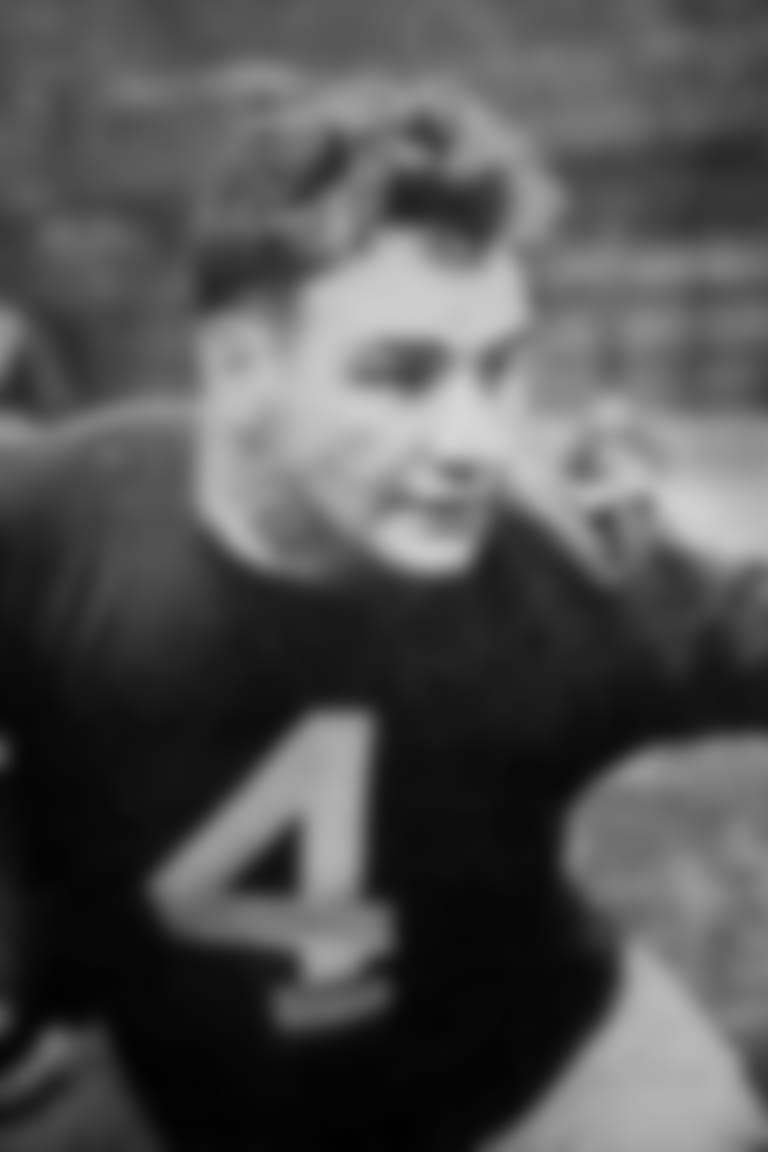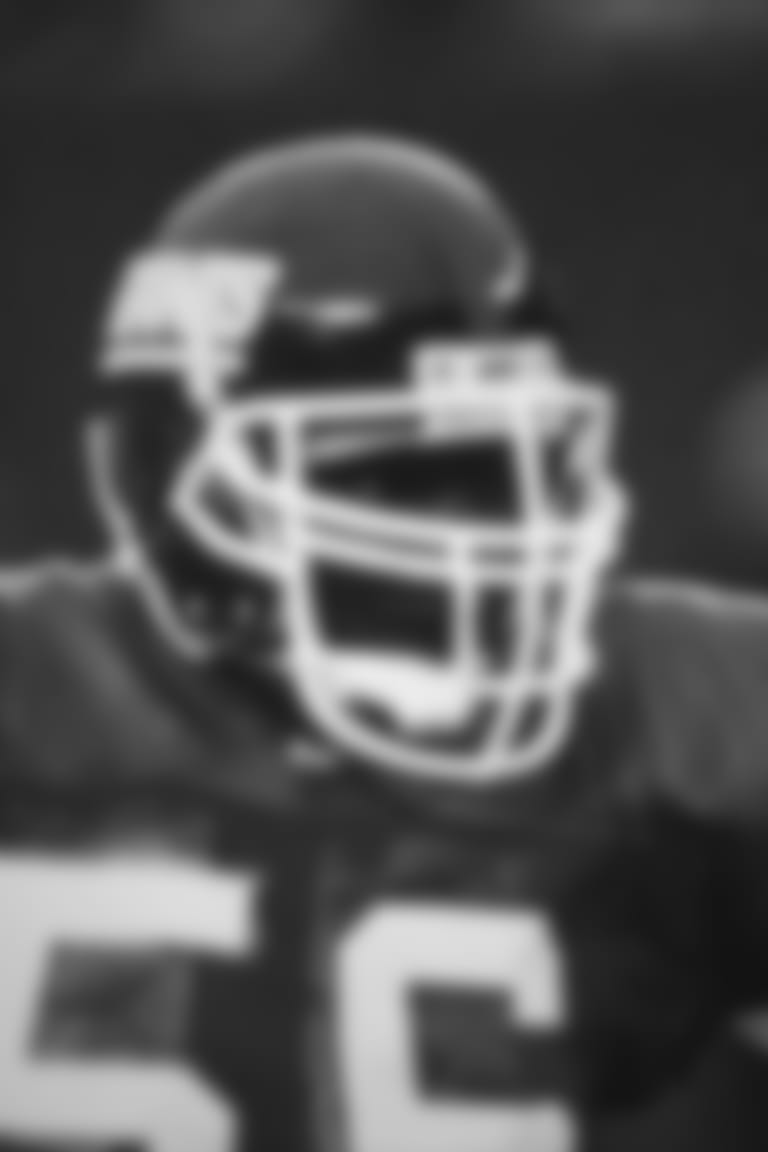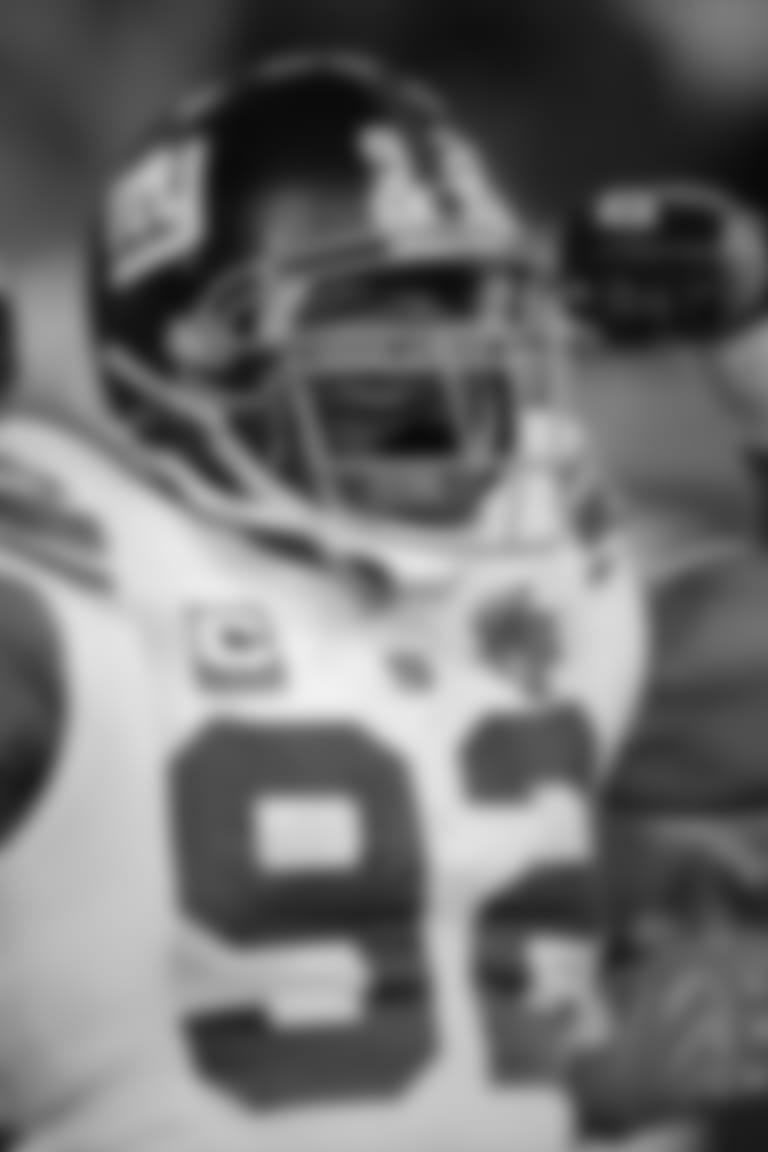Ray Flaherty
Ray Flaherty: No. 1
Ray Flaherty spent most of his playing career with the New York Giants, joining the team in 1929. After leaving in 1930 to coach the Gonzaga Bulldogs basketball team, Flaherty re-joined the Giants in 1931 and stayed with the team through the 1935 season. He was an outstanding end with the Giants, being named First-Team All-Pro three times. In 1932, Flaherty led the NFL in receptions, receiving yards, receiving touchdowns, yards per reception and yards per game. Flaherty helped lead the Giants to a NFL Championship in 1934. When the Giants retired his No. 1 jersey following the 1935 season, it was the first time a professional football team had ever retired a player's jersey number.
Tuffy Leemans
Tuffy Leemans: No. 4
Leemans played for the Giants from 1936-43. He was personally scouted by Wellington Mara and was a sec-ond-round draft choice in the inaugural NFL draft in 1936 out of George Washington. Mara sent a telegram setting up a meeting with Leemans to convince him to accept a career in the NFL with the Giants. Leemans was the 1936 College Football All-Star game MVP. He led NFL rushers as a rookie in 1936 with 830 yards on 206 attempts. Leemans was named All-NFL in 1936 and 1939. An aggressive, dedicated do-everything team leader, he totaled 3,142 yards rushing, 2,324 yards passing, 442 yards receiving and threw 16 touch-down passes during his career. He was enshrined in the Pro Football Hall of Fame in 1978.
Mel Hein
Mel Hein: No. 7
Hein joined the Giants in 1931 and played 15 seasons, a team record matched only by Simms and Strahan. He was named All-NFL eight consecutive years from 1933-40. Following a successful college career at Washing-ton State, Hein wrote to three NFL clubs offering his services. He joined the Giants after the team submitted the highest salary bid at $150 per game. Hein was a 60-minute regular for 15 years, playing in 170 games. He never missed a game in high school, college or the NFL. Hein took time out only in two games and was injured only once. He was named the league's Most Valuable Player in 1938 after anchoring a line that helped guide the Giants to the NFL Championship with a 23-17 victory over the Green Bay Packers in the Polo Grounds. Hein was a member of the Pro Football Hall of Fame's inaugural class in 1963.
Eli Manning
Eli Manning: No. 10
Manning is one of the most accomplished players in the history of Giants football. He is the only player in franchise history to suit up for 16 seasons and his 236 regular-season games (234 starts) and 248 total games are both Giants records. Manning led the Giants to victories against the New England Patriots in Super Bowls XLII and XLVI and was named MVP in both games, becoming the first player in franchise history and one of just five players in NFL history to win the award multiple times. Manning owns every significant Giants career passing record. He is in the top 10 in NFL history with 8,119 attempts and 4,895 completions, 57,023 yards and 366 touchdown passes. Manning also has the franchise's highest career completion percentage (60.29). Manning holds the seven highest single-season completion totals and the four highest yardage totals (he threw for more than 4,000 yards seven times) and completion percentages. Manning's 1,219 passing yards in the 2011 title run are also the most in a single postseason in NFL history. He also set Giants career playoff records with 400 passes, 242 completions, 2,815 yards and 18 touchdown passes. Manning was selected to four Pro Bowls. In 2016, Manning was the co-recipient of the Walter Payton NFL Man of the Year Award. He is the only Giants player to be so honored in the award's history.
Phil Simms
Phil Simms: No. 11
Simms was George Young's first draft choice in 1979 and he played his entire 15-year with the Giants. He overcame a series of injuries early in his career to become the most productive quarterback in team his-tory. Simms holds the Giants career records for pass attempts (4,647), completions (2,576), yards (33,462) and touchdowns (199). He was 95-64 (.597) as a regular season starter and 6-4 in the playoffs. But Simms is best remembered for his almost flawless performance in leading the Giants to victory in Super Bowl XXI. He completed 22 of 25 passes – including all 10 of his throws in the second half – for 268 yards, three touchdowns and no interceptions in a 39-20 rout of the Denver Broncos. In one of the easiest votes in history, he was selected the game's Most Valuable Player.
Y.A. Tittle
Y.A. Tittle and Ward Cuff: No. 14
The Giants engineered one of the best trades in their long history prior to the 1961 season when they sent guard Lou Cordileone to the San Francisco 49ers for Tittle. The then 35-year old Tittle promptly led the Giants to their 12th Eastern Division championship. Tittle played two seasons in the All-American Conference and 11 in the NFL before joining the Giants. In 1962, Tittle set an NFL record by throwing 33 touch-down passes and tied another mark with seven scoring throws in one game. Tittle had his greatest year as a pro in 1963, when he led the league in passing with 221 completions in 367 attempts for 3,145 yards. His 36 touchdown passes broke his own league mark and set a Giants record that still stands. Tittle's career totals include 2,427 completions, 33,070 yards, 242 touchdowns and 13 games with more than 300 yards passing. He was the NFL Player of the Year in 1957, when he led the 49ers to a tie for the Western Division title, and won the honor again in 1961 and 1963, as he took the Giants to Eastern championships. Tittle was named All-NFL in 1957, 1962 and 1963, and also played in six Pro Bowls. He was inducted into the Pro Football Hall of Fame in 1971.
Cuff joined the Giants as a fourth-round draft choice from Marquette in 1937 and excelled at several positions in a stint that ended in 1945. A wingback, fullback, halfback, defensive back and kicker, he rushed for 1,766 yards on 330 carries (a 5.3-yard average) and caught 101 passes for 1,477 yards. Cuff scored 18 touchdowns (six rushing, 12 receiving) and made 31 of 70 field goal attempts and 98 of 102 extra point tries. He also had a 12.1-yard punt return average and 13 interceptions.
Frank Gifford
Frank Gifford: No. 16
A Pro Football Hall of Fame inductee in 1977, Gifford played for the Giants from 1952-64, although he voluntarily retired in 1961 due to a serious injury suffered the previous season. He was known as one of the most versatile backs in NFL history. Gifford was the first choice in the draft by the Giants in 1952 after an All-America career at Southern California. He totaled 9,862 combined yards during his career. He rushed for 3,609 yards, caught 367 passes and scored 484 points. Gifford was named to the Pro Bowl as a defensive back in 1953 and as an offensive back the following year - a first in NFL history. He played in seven Pro Bowls and was named All-NFL four times and NFL Player of the Year in 1956. Gifford holds the Giants record with 78 touchdowns. A true triple-threat back, Gifford threw 14 touchdown passes in 60 attempts on the halfback option. He retired after the 1960 season and returned in 1962 at a new position, flanker. The Giants reached the NFL Championship game five times during his career, including their victory in 1956.
Al Blozis
Al Blozis: No. 32
Al Blozis played just three seasons for the Giants, 1942-44. He immediately made a favorable impression on the team after arriving in 1942 and quickly earned a starting assignment at tackle. Blozis played in the 1944 championship game against Green Bay. Immediately after the Giants' loss to the Packers, Blozis was sent overseas to fight in World War II. An Army lieutenant, he was killed in action in France just six weeks later. The Giants retired Blozis' No. 32 jersey.
Joe Morrison
Joe Morrison: No. 40
Morrison was a back and an end for the Giants from 1959 through 1972. A dominant figure during his 14-year career, he totaled 2,472 rushing yards and 18 touchdowns. He also caught 395 passes – the third-highest total in franchise history - for 4,993 yards and 47 scores. A versatile player, Morrison played six different positions: fullback, halfback, flanker, tight end, split end and defensive back. Morrison's No. 40 jersey has been retired by the franchise.
Charlie Conerly
Charlie Conerly: No. 42
Conerly is often called the best Giants player not in the Pro Football Hall of Fame. He played his entire career with the Giants from 1948-61 and was a vital member of the 1956 NFL Championship team. Conerly was the NFL Rookie of the Year in 1948, the league's Most Valuable Player in 1959 and a Pro Bowler in 1950 and '56. Conerly ranks third in franchise history in pass attempts (2,833), fourth in completions (1,418), third in yards (19,488) and touchdown passes (173). He is also second in Giants history with 167 interceptions.
Ken Strong
Ken Strong: No. 50
Strong played for the Giants from 1933-35, in 1939 and from 1944-47. He excelled in every phase of the game - blocking, running, passing, punting, placekicking and defense. At the time of his retirement, Strong was the Giants' career scoring leader with 324 points on 13 touchdowns, 35 field goals and 141 extra points. He scored 17 points to pace the Giants to the 1934 championship game over the Chicago Bears in the famous "Sneakers Game." Strong scored a league-high 64 points in 1933 and was All-NFL in 1934. He began his career with the Staten Island Stapletons in 1932. After four seasons, he joined the Giants. In 1936, he began a two-year stint in the rival AFL. Strong served as a placekicking specialist only when he returned to the Giants from 1944 until 1947. He scored 479 points in his career. Strong was enshrined in the Pro Football Hall of Fame in 1967.
Lawrence Taylor
Lawrence Taylor: No. 56
Taylor joined the Giants as the second overall selection of the 1981 NFL Draft and played his entire 13-year career for the team. When Taylor retired, he was the NFL's No. 2 all-time sack leader in the NFL with 132.5. That total does not include the 9.5 he accumulated as a rookie in 1981 before the sack was an official NFL statistic. Taylor established an NFL record by appearing in 10 consecutive Pro Bowls from 1981-1990. He was named the NFL Rookie of the Year in 1981 and the NFC's Defensive Player of the Week nine times (the award was established in 1984), as well as the conference's Defensive Player of the Month twice, in October 1986 and September 1989. Taylor was a unanimous choice to the NFL's All-1980s team. He was a unanimous selection as the NFL's Most Valuable Player in 1986, when he had a career-high 20.5 sacks, 105 tackles, five passes defensed and two forced fumbles. He was inducted into the Pro Football Hall of Fame in 1999.
Michael Strahan
Michael Strahan: No. 92
Few players in Giants history were as dependable and productive as Strahan. He seldom missed a practice and played in a franchise-record 216 regular season games. Beginning in 1996, he played in 136 consecutive games before tearing his pectoral muscle midway through the 2004 season. Strahan was selected to seven Pro Bowls, was named the 2001 NFL Defensive Player of the Year and was the Giants' Most Valuable Player that year and in 1998. He was a captain on the 2007 Super Bowl championship team. His 141.5 sacks are the highest official total in team history (Taylor had 142.0 but 9.5 as a rookie in 1981, the year before sacks became an official statistic) and the fifth-highest total in NFL history. He set the league's single-season sack record with 22.5 in 2001 and his NFL-best 18.5 sacks in 2003 made him the Giants' only two-time league leader in that category. Strahan's 868 tackles indicates he was also an excellent defender against the run. He was inducted into the Pro Football Hall of Fame in 2014.















